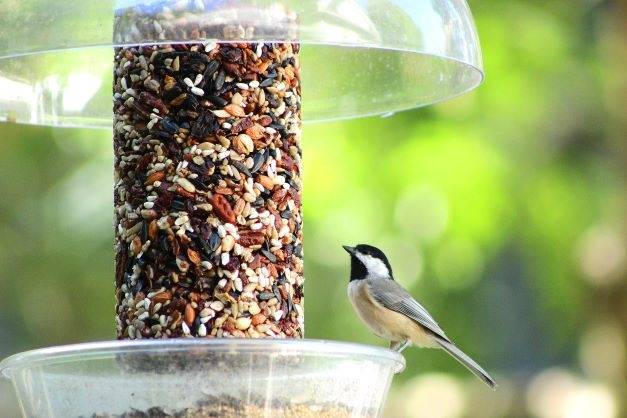Backyard Birding

Do you want to become a birder, but don’t know where to start? Why not start in your own backyard? Backyard birding is a great way to connect with the biodiversity around us. There are many species around us each and every day that we likely don’t even notice. Once we take notice of one aspect of the natural world around us, like birds, we begin to unlock curiosity for more and more. Imagine, you finally identify the little brown bird in your yard as a Song Sparrow and can even recognize it by its song. Now, you start to wonder, “what is the species of that tree it’s always perched in?” or “what foods does it prefer to eat and why?”. If you are thinking about starting your birding journey in the backyard, these tips will help you spread your wings and soar!
First, it is a good idea to have multiple different types of feeders to attract more species of birds. Some birds prefer platform feeders, some like tube feeders with a perch, and others just enjoy the simplicity of enjoying their seeds on the ground. Woodpeckers have an interesting adaptation to perching on vertical tree trunks. They use their tail to push against the trunk while they hold on with their talons. The best feeders to attract woodpeckers have a vertical platform below the perch allowing them to use their adapted tail for balance. Place the feeders in the yard on a shepherd’s hook or tree that is easily watchable from an indoor or outdoor viewing place. It is recommended to clean your feeders once every 2 weeks with 9:1 water to bleach dilution. Dirty feeders can invite bacteria and diseases like mycoplasmal conjunctivitis, salmonellosis, and aspergillosis. According to Cornell Lab of Ornithology, you should double how often feeders are cleaned if you detect any sick birds.
Next, it’s time to consider what kinds of seeds to put out. This can have a strong effect on which birds come to your yard. Jays love peanuts, shells and all! Black-oil sunflower seeds are a real crowd-pleaser attracting many different species like Black-capped Chickadees, House Finches, and Sparrows, just to name a few. No-mess seed is another great option because it includes a mix of different seeds with the shells removed. This means the birds have to do less work to enjoy their meal and there is less mess to clean up beneath the feeder! Another common seed to use is nyjer seed, which is a big hit with the goldfinches, juncos, and redpolls. You might also consider putting out fresh fruit, like halved oranges, for the tanagers and orioles, but be sure to discard the fruit before it rots or molds. If you notice that squirrels or deer are eating more of the birdseed than the actual birds, you may need to take action. There are feeders that claim with varying levels of reliability to be resistant to non-avian species, but there are also other methods you can try. Fun fact, birds do not react to capsaicin (the chemical that makes things taste spicy) the way mammals do. Mixing cayenne pepper into your bird seed will deter squirrels and deer, but will not bother the birds.
Last, but not least, you might consider buying a pair of binoculars. Depending on how far away the feeders are from your viewing spot, a decent pair of binos can make a huge difference in the quality of your experience. Binoculars with 8 power and 42mm objective lenses, represented as 8×42, are great standard specs for any beginning birder. This type of binocular will allow you to see birds in 8 times magnification as well as provide decent brightness to see important details. Some popular brands are Celestron, Nikon, and Zeiss. Every year, the National Audubon Society publishes an extremely helpful Guide to Binoculars that rates many different brands and models and separates them into different price categories. The price of binoculars can range from about $130 to around $3,000! Using a guide to binoculars, like the one from the National Audubon Society, can be a great way to find which pair is right for you. Now you are ready to start your “life list”. This is a list of every bird species you detect in your lifetime. The most common method of recording this data is through an app called eBird. Once you make a free account, you can submit a list every time you go birding. The app will keep track of location, time, date, and species so you can look back on past birding experiences anytime. Additionally, eBird is a great example of crowdsourcing data. This allows scientists all over the world to use the data to study bird populations. That means, by recording the birds you see in your yard in eBird, you are participating in community science that helps to study and conserve birds!
By: Meghan Halaburda